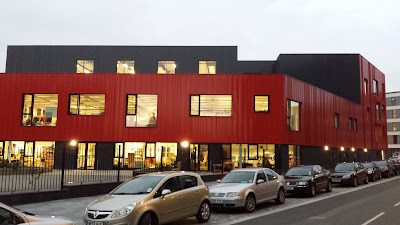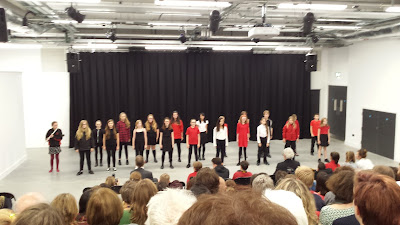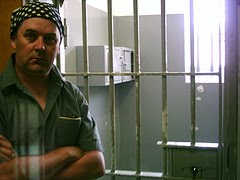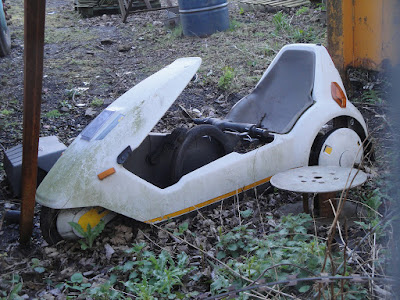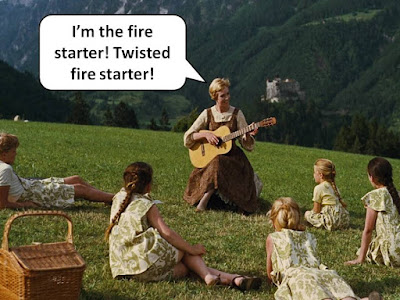 |
| Image source: Deviant Art http://mjmstudios2020.deviantart.com/art/ |
Many people are excited about today - Wednesday 21st October 2015. The reason? It's
Back to the Future Day - the day the fictional characters Marty McFly and Dr Emmett Brown arrive from 1985 into 'the future' in the wonderful science fiction movie trilogy Back to the Future. There will be many blogs and articles celebrating this today. So here's one more (I refuse to be left out). Back in the late 80s and early 90s, the films were a must for everyone of a certain age. Those of us who were the same age as Marty, late teens, early twenties, were fascinated by what we might be doing in the future. Would we still be alive when 2015 arrived. What age would each of us be? What would 2015 bring us? How would we cope with all the new technology? What jobs would we be doing? Would we have children? Grandchildren? These are the reasons why so many of us are excited by the fact that the date has finally arrived, so we can look back on time, and compare what we hoped and expected with today's reality. We are all time travellers - in one direction at least.
In
Back to the Future 2, Doc brings Marty and his girlfriend Jennifer, into to the future to try to avert a personal disaster. This is the old timeline trope where you go back in time to change something there, in the hope that it will make your own present better in some way. However, the twist in Back to the Future Part 2 is that Marty has to travel into the future to redeem his present. Along the way there are many twists and turns, and a temporal dance of intricate proportions results. It's a splendid yarn, and it kept us entertained for some time back in the day. Yet, looking at the movie now, how many of the technologies that were predicted actually exist, and what does it mean for us, living in 'the future' of 2015?
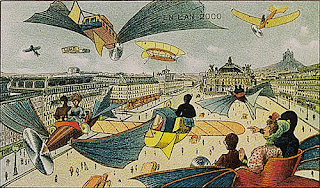 |
| Source: http://www.flickriver.com/photos/amphalon/sets/ |
Flying cars are a classic example of a technology that has been predicted for more than a century. The French artist Villemard painted images of flying vehicles back in 1910. We are still waiting, because, after all, do we really need or desire flying cars? How might they make our lives better, and what attendant risks and challenges might the flying car bring to our already complicated 21st Century lifestyles? Driverless cars are probably enough to be grappling with right now. Other similar technologies featured in BTTF2 included self lacing footwear, self-drying and adjusting clothing, and yes - the
hoverboard. Back in the eighties, skateboards were new and exciting. Now it seems they are largely consigned to the hardcore of youths who regularly try to severely injure themselves by performing dangerous tricks on hard surfaces in deserted city centres in the evenings. Whether or not hoverboards have been invented or indeed are commercially viable is open to discussion, but we already have
Maglev trains that work on a similar principle, so we could say that this prediction is partially fulfilled.
Other technologies are conspicuous by their absence. There is no mention of the Internet in the movie. Where are smartphones and
social media? All are missing because they either didn't figure in the minds of the writers, or they simply hadn't been invented at the time the movie was being made. Other technologies are laughable by their inclusion - think of the Fax machines middle-aged Marty's boss uses to fire him from his job. Does anyone still use fax machines in 2015? Controlling the weather? Hmmm. And what about the inverted, gravity defying orthopaedic frame used by Marty's ageing father George McFly? Hardly credible then, or now.
One interesting technology that does appear in the movie was nascent in 1985, but it did exist - video conferencing, and it is portrayed accurately in BTTF2. Note that several times in the movie, the characters communicate with each other through wall screens that project images and sound. I first saw
videoconferencing in 1972, it has been around for a while in various forms, and it was already featuring as a futuristic means of communication in such TV shows as Star Trek. It wasn't hard to include it as a future means of communication, and of course this is particularly accurate with the advent of
FaceTime, Skype and other similar visual media. But it's an isolated case of accuracy in the midst of mis-predictions.
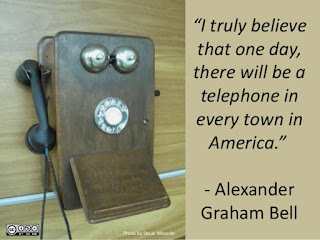 |
| Image and graphics by Steve Wheeler |
We run the risk of ridicule when we try to predict the future. No-one has been there. It's impossible to predict it with great accuracy.
Alexander Graham Bell, credited with inventing the telephone, was so excited by his wonderful idea he made this declaration (left). He was
right. Every town in the U.S. has a telephone. But it's a ridiculous statement, in hindsight. The fact is, everyone who wants a cell phone has one (or more) in their pockets. Bell couldn't predict the future beyond his current frame of reference, because as Voltaire once pointed out:
'Every man is a creature of the age in which he lives, and few are able to raise themselves above the ideas of the time.' Those who can break out of their current thought culture, and imagine a different future, are the visionaries who create that future.
Voltaire also said
'The present is pregnant with the future'. Go make your own future.
P.S. I'm a big fan of the Back to the Future trilogy, so if you try to suggest I'm dissing these movies, your comments will die at the moderation stage. :)

Backing the future #BackToTheFuture by
Steve Wheeler was written in Plymouth, England and is licensed under a
Creative Commons Attribution-NonCommercial-ShareAlike 3.0 Unported License.



